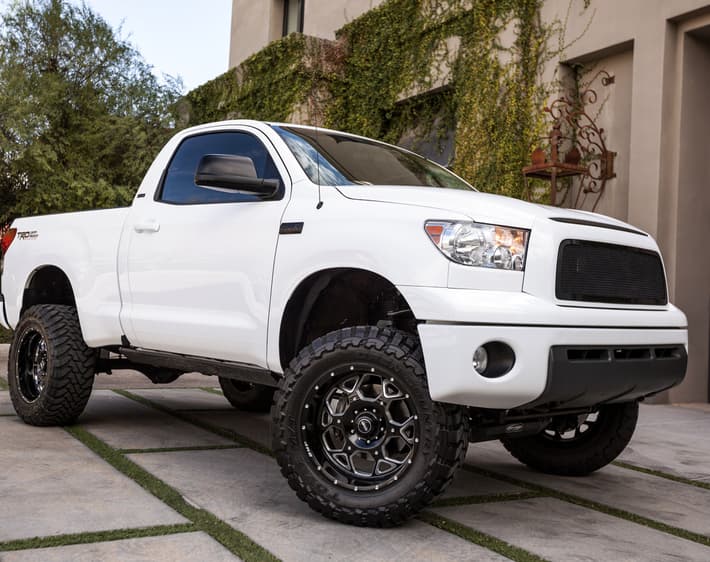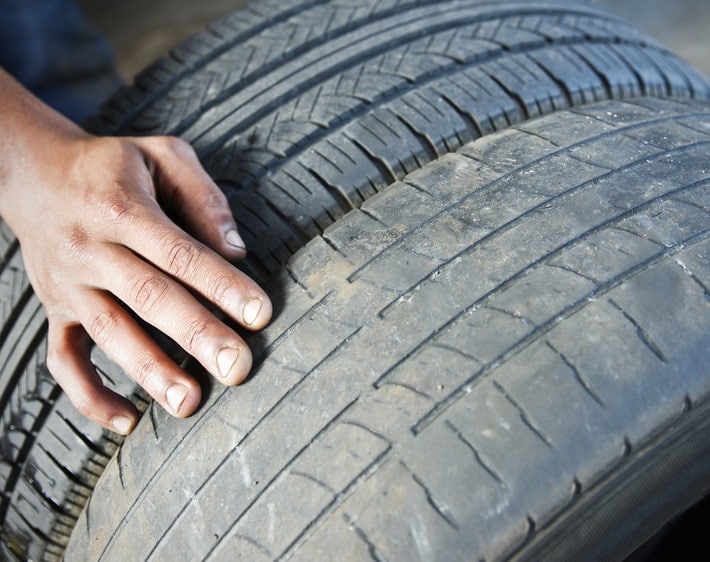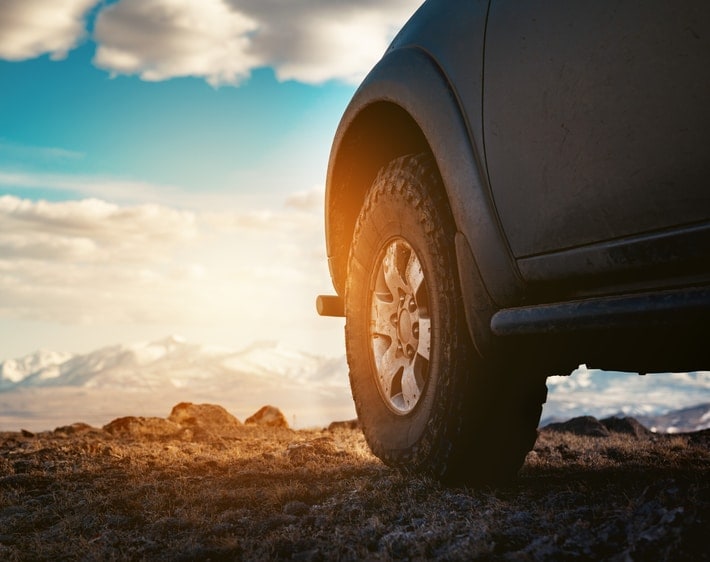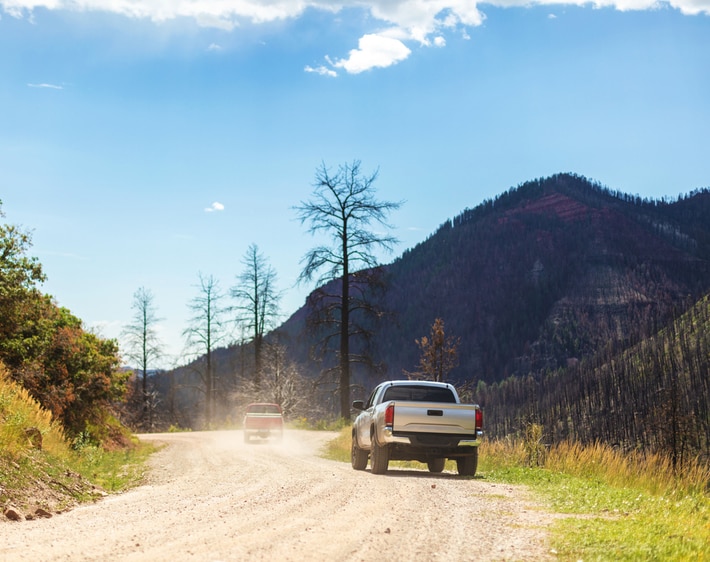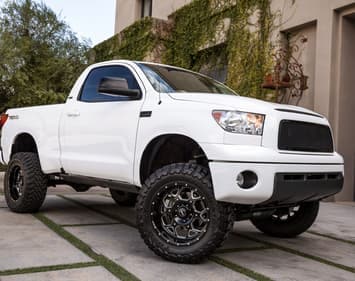 If you’re wondering, “Can I use bigger tires on my car?” the answer is usually, “It depends.” Before you buy that new set of wheels, there are a few things you should know about putting bigger tires on a car.
If you’re wondering, “Can I use bigger tires on my car?” the answer is usually, “It depends.” Before you buy that new set of wheels, there are a few things you should know about putting bigger tires on a car.
While there are many benefits of bigger tires, prospective buyers should consider how bigger tires affect vehicle stability, safety, fuel economy, and speedometer accuracy — among other essential pros and cons of upsizing tires on trucks and SUVs.
Bigger Tires, Bigger Wheels, or Both?
At Tires Plus, we always recommend that you follow your vehicle manufacturer’s recommendations for tire selection and sizing. However, some motorists choose to slightly deviate from their vehicle’s original tire and wheel size for performance or style purposes.
Plus-Sizing
Plus-sizing involves installing wheels with a larger diameter with a low-profile tire that’s the same diameter as the original — meaning it doesn’t impact ground clearance or the speedometer. In some cases, plus-sizing helps enhance a vehicle’s cornering and handling performance capabilities. However, in most situations, this is purely a stylistic choice. Our expert technicians can help give you guidance on if and how your vehicle’s tires should be plus-sized.
Up-Sizing
Up-sizing involves deviating from the manufacturer-recommended tire size by installing tires with a larger diameter on wheels that are the same size or bigger. Up-sizing impacts the speedometer, meaning it requires reprogramming the vehicle’s computer.
Additionally, larger tires weigh down the wheel assembly — which may affect fuel economy and place unnecessary stress on the powertrain and brakes. If planned or installed incorrectly, up-sized tires may also rub the wheel well, brake calipers, or vehicle frame, potentially wearing down any parts they grind against.
At Tires Plus, we generally recommend against up-sizing your vehicle’s tires.
What Happens When You Put Bigger Tires on Your Car?
It's best to follow your vehicle manufacturer’s guidelines for tire selection and sizing, as right-sized tires help support proper stability and performance. If you decide to change your tires from their original size, make sure that the new tires meet or exceed your vehicle’s load-carrying capacity at the proper inflation pressure, and consider if the taller tires will impact any Advanced Driver Assistance Systems.
Additionally, check beforehand that the larger tires you want are compatible with your wheels and rims’ size and that they don’t rub against the calipers or sides of the wheel well.
When you put bigger tires on your car, SUV, crossover, or light truck, you raise the vehicle’s clearance — increasing body roll and load transfer, which may negatively impact your car’s balance and speed.
Pros and Cons of Bigger Tires on Trucks & SUVs
Pro: Increased Clearance
Perhaps the most significant benefit of larger tires is the extra distance it creates between your car’s undercarriage and the ground. This is particularly important for off-roading enthusiasts who need that extra space to clear rough terrain.
Higher clearance also helps drivers see farther both on and off the road. Depending on your needs, upgrading tire size can mean installing massive 40-inch tires that can traverse boulders or merely adding a few extra inches of diameter.
Con: Added Costs & Adjustments
Up-sizing your truck’s tires is more complicated than just installing larger tires on the wheels and calling it a day. In some cases, you will have to install new wheels that are compatible with your larger tires. If the tires you want are too big for your wheel well, you may have to install a lift or leveling kit to make room for them, which could affect getting proper wheel alignment services in the future.
While new rims and lift kits are often a desirable and trendy addition to bigger tires, they also represent additional costs that you must factor into your decision!
Additionally, a set of bigger tires means you will need to adjust both the speedometer and possibly the tire pressure target data to accurately reflect the correct speed, the corresponding correct miles driven, and any target PSI changes with your new wheels.
There isn't much to change with the TPMS besides swapping it to the new wheels and relearning positions if needed. Only some vehicles allow access to the Electronic Control Module (ECM) to change the tire size in the computer so it reflects on the odometer and speedometer.
Pro: Better Off-Road Performance
Some believe that, because bigger tires result in higher ground clearance, they offer superior off-road handling. However, finding all-terrain or max-traction tires in the right size for your truck or SUV can also benefit its performance off the beaten path. With deeper and broader treads to grip uneven and loose terrain, max traction tires are tough enough to go wherever the trail takes you!
Con: Lower Fuel Economy
All that extra tire can seriously lower fuel economy. Bigger, more aggressive tires are great for backcountry trails but can be noisy and inefficient on paved roads. A deeper and wider tread can increase your vehicle’s rolling resistance, which means your car has to work harder to overcome the “stickiness” of all that extra traction.
Pro: Customization & Curb Appeal
Bigger tires — usually accompanied by bigger rims and higher suspension — are a popular trend among truck drivers. While some people want the off-roading advantages that come with bigger tires, sometimes the big wheels are all about style points. Upgrading your tire size is one way to customize the look and feel of your driving machine.
Con: Change in Handling
Naturally, increased height from larger tires means you have a higher center of gravity. This changes the handling of your vehicle by increasing body roll and load transfer. In some cases, you may experience less stability when braking and cornering — especially if traveling at high speeds. Additionally, any changes in ride height and in some alignment angles may result in the Advanced Driver Assistance Systems needing recalibration.
Con: Potential Voided Warranty
Style points aside, some manufacturer’s will explicitly advise against increasing your vehicle’s tire sizes. Additionally, certain automakers will even void your vehicle’s warranty if you decide to modify its suspension with larger tires and a lift kit.
Do Bigger Tires Affect MPG?
Putting bigger tires on your car will affect your vehicle's average miles per gallon (MPG). There are several reasons larger tires lower fuel economy.
First, bigger tires are usually much heavier. Adding a set of four big and heavy tires to your vehicle will add a lot of new weight. That added weight can hurt your car’s acceleration and expend more fuel. It can also put more strain on your brakes to slow down the vehicle.
Second, wider tires may stick out from the wheel well instead of staying in line with your truck or SUV. This can make your car less aerodynamic and increase fuel usage.
Lastly, as previously mentioned, wider and more aggressive tires have a larger contact patch with the road that can increase rolling resistance.
Do Bigger Tires Affect the Speedometer?
Modifying your car with larger tires will alter the accuracy of your speedometer. This is because part of the speedometer’s read-out is measured by the revolution of your tires, based on the tire’s circumference.
When you install bigger tires, if the speedometer is not recalibrated to the new tires’ increased circumference, it will not display the correct speed. You will need a technician to either adjust the speedometer gear or reprogram your vehicle’s computer to compensate for the change in tire size if applicable.
Tire Recommendations You Can Trust
Want to upgrade your vehicle’s tires but not sure where to start? Head to a Tires Plus in your city to talk to our experts about plus-sizing, off-roading tires, and everything in between. We'll help you pick out the right size, type, and tread style for your make and model so you can get the tires you need for the driving experience you've always wanted.
